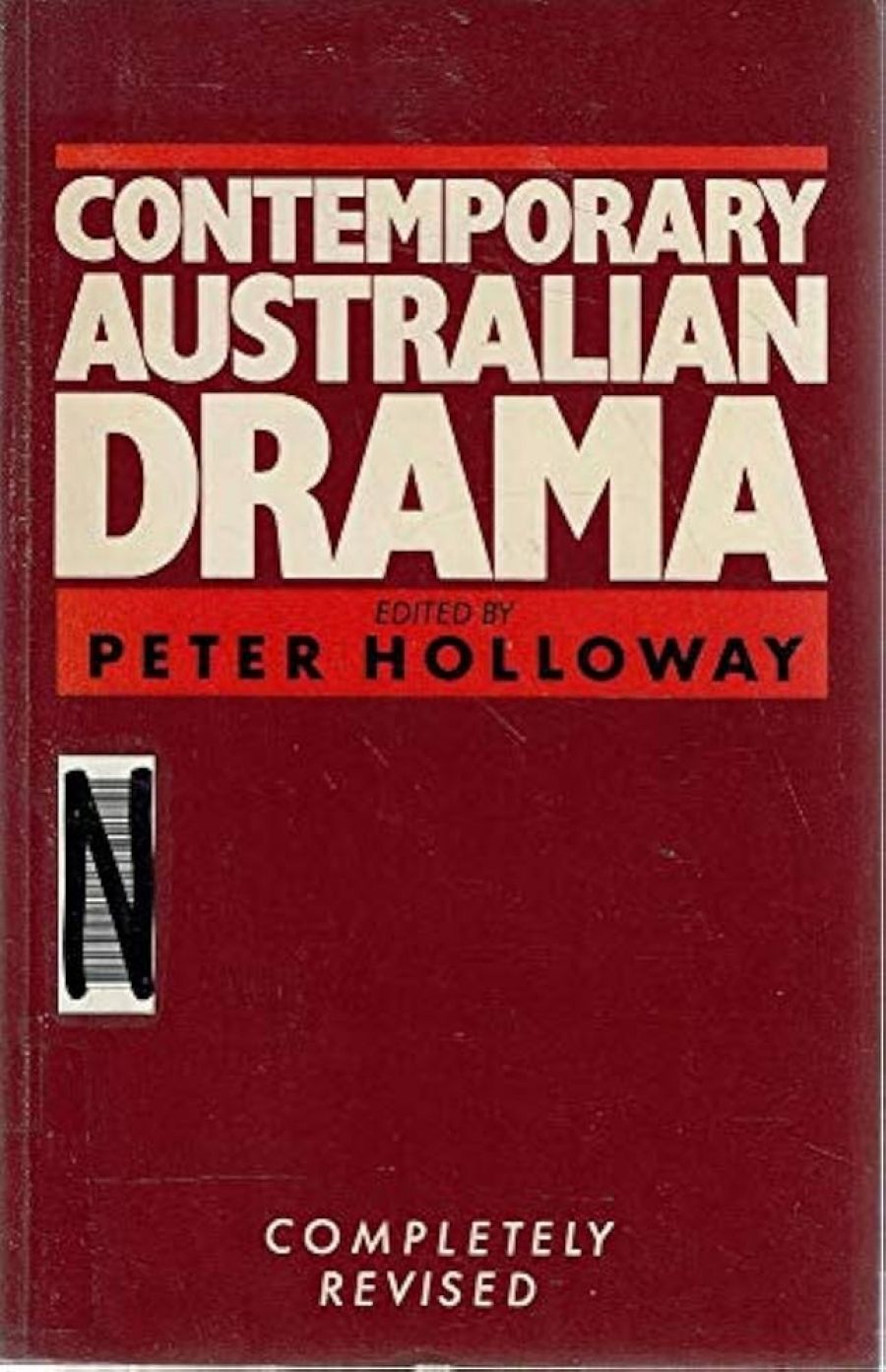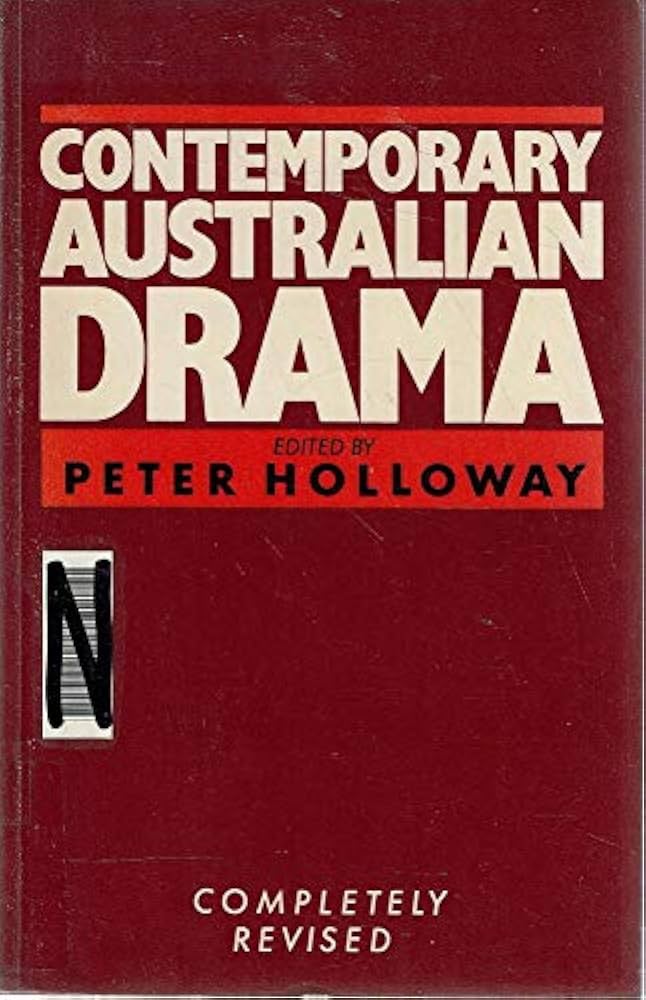
- Free Article: No
- Contents Category: Theatre
- Review Article: Yes
- Article Title: Where are the pictures?
- Online Only: No
- Custom Highlight Text:
I don’t know why a book – and one that has been ‘completely revised’ for its second edition – about one of the world’s more interesting (dare we say exciting) recent cultural developments – the progress of Australian drama from the nineteen fifties to the present –should be so standardised as to read like a school text-book. But I suppose that’s where the answer lies: it’s like a text book because that’s the market.
- Book 1 Title: Contemporary Australian Drama (Second Edition)
- Book 1 Biblio: Currency Press, $29.95 pb, 628 pp
- Book 1 Cover Small (400 x 600):

- Book 1 Cover (800 x 1200):

Of course, with this sort of book, no one is expected to read, as I did, from cover to cover. If you do, you’ll find that chapters start again and again with the well-worn and acknowledged truths of our theatrical past. By the time you get to the 380s, still to be reading of the ‘Doll’ and its naturalistic underlines, the rough and tumble ‘dingo’ school of new-nationalism at the APG, the new-wave new-internationalists of recent years, Patrick White’s and Dorothy Hewett’s queer but commendable ‘poetic’ drama ... you long for something or someone to turn the whole thing upside down.
Mind you, when somebody writes a good piece, it certainly stands out. and this second edition has its share, John McCallum’s essay ‘The Development of a Sense of History in Contemporary Australian Drama’ is like a breath of fresh air. Suddenly, instead of examining plays in terms of inadequate stylistic classifications (I’m still no clearer, really, about what exactly ‘naturalism’ is), John McCallum casts a new structure of thought over some thirty years of playwriting and provides us with a new way of seeing. Jeremy Ridgeman meanwhile, in ‘The One-Actor Play in Australian Drama’, expends considerable energy discussing that ‘difficult question of terminology’: should Jack Hibberd’s series of ‘monodramas’ more correctly be termed ‘egodramas’!
Joy Hooton throws up what is finally an interesting reading of ‘The Doll’ Trilogy in which Olive and Barney become the ‘unwitting villains’ and makes reference at least to both Rodney Fisher’s and Jean-Pierre Mignon’s recent productions. Some of the contributors seem not to have actually seen a production of the plays they discuss, though as Peter Fitzpatrick points out in ‘After the Wave: Australian Drama Since 1975’good old Sydney Melboume rivalry could have something to do with that:
But Louis Nowra and Stephen Sewell, the two outstanding playwrights to emerge in the last decade, have both been shamefully neglected in Melbourne.
(On this note it made me feel almost sentimental to come across Jack Hibberd’s 1977 praise of John Stunner’s ‘adroit orchestration of comedy’:
– the majority of it was not signalled a la Sydney: that is, the patrons were not treated as a collection of complete Pavlovian half-wits.
There’s a refreshing article from Clive James, ‘Approximatches in the vicinity of Barry Humphries’, where he manages to balance a real affection and admiration for Humphries with a clear perspective on where his characters go beyond their creator’s control. It was wonderful to read that those stories of Humphries’ Dadaist performance ‘events’ of the early sixties (such as Barry Hying to London and sometime during the flight producing a spoon and eating a quantity of potato salad that had unobtrusively been emptied into his air sickness bag) had actually happened.
There’s a fine posthumous tribute by the late Peter Kenna to the fourplays of Jim McNeil in which he considers them, beautifully, as plays about happiness informed by ‘the ideals of humanity and good fellowship’. A terrific essay by Veronica Kelly, ‘A Mirror for Australia: Louis Nowra’s Emblematic Theatre’, examines the early plays – particularly the ‘internationalist’ plays Inner Voices and Visions – and reads the mas parables of Australia as a colony which prepare the way within Nowra’s own dramatic vocabulary for the mighty Inside the Island that followed. And there are new, worthy contributions from Eunice Hanger, Peter Fitzpatrick (3 articles), John McCallum (2 articles), Margaret Williams, and Wayne Harrison (the only one to look inside a rehearsal room).
There’s an extraordinary article by Axel Kruse in which he pursues a favourite obsession that the late works (i.e. post-closet) of Patrick White are fundamentally a chance for an old poof to dress up and shake his titties and bare his bum at his audience because he feels he’s got nothing left to lose. Now, there is perhaps some truth in this reading. (And if Axel Kruse had written his article after seeing White’s recent Shepherd On The Rocks in which protagonist Danny Shepherd is given a solo spot talking to the audience about the advantages of wearing fishnet on a hairy leg, minutes before his great last speech, he could have gone to town!) And it is certainly satisfying to have a perspective on the late work that is from a different angle to those of Leonie Kramer and Harry Kippax. But it misses both the fundamental seriousness and the tenderness of the works. He simply goes too far. To extract the words ‘blowing’, ‘one hand’ and ‘pulling’ from the end of Act One of Signal Driver and suggest that they point to a hidden meaning of masturbation, is to confuse their actual meaning which concerns Australian laissez-faire and Japanese imperialism. And although there are, as Axel Kruse submits, several meanings of ‘drag’ used through the works, and although the stage directions are often part of the ‘game’ being played by White in these plays, to suggest that Theo ‘dragging’ at Ivy in order to get her home out of the night air at the end of Signal Driver, hides a cunning reference to transvestite behaviour, is just silly.
However, one considerable achievement of Axel Kruse’s essay is that it looks at these plays as theatre, as performed, which so few of the contributors to this book seem really prepared to do. Looking back over the contributions from the First Edition as well, the things that stay in my mind are the great descriptions of performance: Harry Kippax’s magnificent account of Zoe Caldwell’s Nola Boyle; Garrie Hutchinson pointing out some moments in the original Floating World that were ‘terrible’, ‘but on the whole Lindzee Smith’s direction is fine, and Romcrilwill undoubtedly revise the play now that he can see it in performance’; the discussion of Wai Cherry’s Emerald Hill Company by Gus Warby. These moments all suggest that our theatre history has been a living reality. Think how helpful it would be in understanding Shakespeare if what was recorded was the life of performance, the feeling of production, the relationship of writers to companies of actors.
But unfortunately, this book sticks by and large to the conventions of English Lit. Reference work. It’s a pity because there are a few jewels locked inside it. Editor Peter Holloway makes an attempt to anticipate criticism by making glancing reference to the other areas the book might have covered, but their mention serves merely to draw attention to their absence. A lot of questions are begged. Why is there no discussion of Aboriginal Theatre in this country – particularly given the extraordinarily prolific relationship of director Andrew Ross and playwright jack Davis? Why is there no discussion of theatre for community or youth audiences? The work of David Holmes, for example, or Deborah Oswald, or Sidetrack. . . Why is there no real discussion of musical theatre? Of Nick Enright’s widely performed On The Wallaby for instance, or his collaborations with John Bell and Terry Clarke? Why are Robyn Archer, Bobby Merritt, Bill Harding, Dennis Watkins (alias Lamont Cranston), for example, not included in the partially comprehensive ‘Playwrights’ Checklist’?
And why, oh why are there no photos?


Comments powered by CComment